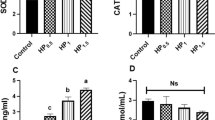Abstract
Host tissues and zooxanthellae of the giant clam Tridacna gigas contained glutamine synthetase, with the highest transferase activities present in the gill, followed by the kidney, mantle, zooxanthellae, foot, heart and adductor muscle, in that order. Synthetase activities of glutamine synthetase in host tissues and zooxanthellae were in a similar order, but the differences were not so marked. Host tissues also contained hexokinase, glucose-6-phosphate dehydrogenase and malate dehydrogenase. Highest hexokinase activities were present in the heart, followed, in order, by the gill, mantle, adductor muscle and foot. Highest glucose-6-phosphate dehydrogenase activities were present in the gill, followed by the mantle, heart, adductor muscle and foot. All tissues assayed contained high malate dehydrogenase activities. There was no detectable glutamate dehydrogenase activity. Glutamine synthetase activity in gill and mantle tissue decreased by 1.6% with every 1 cm increase in clam size. Host glutamine synthetase activity decreased by 80% in gill tissue and by 45% in mantle tissue in clams which were maintained for 8 d in continuous darkness. Similar effects were found when clams were kept in light in the presence of elevated ammonia concentrations. It is suggested that both host and symbionts are nitrogen-deficient in small clams and that host glutamine synthetase plays a role in ammonia assimilation by the intact association.
Similar content being viewed by others
References
Anderson, S. L., Burris, J. E. (1987). Role of glutamine synthetase in ammonia assimilation by symbiotic marine dinoflagellates (zooxanthellae). Mar. Biol. 94: 451–458
Belda, C. A., Lucas, J. S., Yellowlees, D. (1993). Nutrient limitation in the giant clam—zooxanthellae symbiosis: effects of nutrient supplements on growth of the symbiotic partners. Mar. Biol. 117: 655–664
Bradford, M. M. (1976). A rapid sensitive method for quantitation of microgram quantities of protein utilizing the principle of protein dye binding. Analyt. Biochem. 72: 248–254
Dudler, N., Yellowlees, D., Miller, D. J. (1987). Localization of two l-glutamate dehydrogenases in the coral Acropora latistella. Archs Biochem. Biophys. 254: 368–371
Fitt, W. K., Heslinga, G. A., Watson, T. C. (1993a). Utilization of dissolved inorganic nutrients in growth and mariculture of the tridacnid clam Tridacna derasa. Aquaculture, Amsterdam, 109: 27–38
Fitt, W. K., Rees, T. A. V., Braley, R. D., Lucas, J. S., Yellowlees, D. (1993b). Nitrogen flux in giant clams: size-dependency and relationship to zooxanthellae density and clam biomass in the uptake of dissolved inorganic nitrogen. Mar. Biol. 117: 381–386
Guiz, C. D., Hirel, B., Shedlovsky, G., Gadal, P. (1979). Occurrence and influence of light on the relative proportion of two glutamine synthetases in rice leaves. Pl. Sci. Lett. 15: 271–277
Hastie, L., Watson, T. C., Isamu, T., Heslinga, G. A. (1992). Effect of nutrient enrichment on Tridacna derasa seed: dissolved inorganic nitrogen increases growth rate. Aquaculture, Amsterdam 106: 41–49
Kawaguti, S. (1953). Ammonium metabolism of the reef corals. Biol. J. Okayama Univ. 1: 171–176
Miller, D. J., Yellowlees, D. (1989). Inorganic nitrogen uptake by symbiotic marine cnidarians: a critical review. Proc. R. Soc. (Ser. B) 237: 109–125
Muscatine, L., D'Elia, C. F. (1978). The uptake, retention and release of ammonium by reef corals. Limnol. Oceanogr. 23: 725–734
Muscatine, L., Porter, J. W. (1977). Reef corals: mutualistic symbioses adapted to nutrient-poor environments. BioSci. 27: 454–460
Rees, T. A. V. (1986). The green hydra symbiosis and ammonium. I. The role of the host in ammonium assimilation and its possible regulatory significance. Proc. R. Soc. (Ser. B) 229: 299–314
Rees, T. A. V. (1990). Alga-invertebrate symbioses and nitrogen: recycling or conservation? In: Nardon, P., Gianinazzi-Pearson, V., Grenier, A. M., Margulis, L., Smith, D. C. (eds.) Endocyto-biology 4. Institut National de la Recherche Agronomique (INRA), Paris, p. 315–318
Rees, T. A. V., Ellard, F. M. (1989). Nitrogen conservation and the green hydra symbiosis. Proc. R. Soc. (Ser. B) 236: 203–212
Rees, T. A. V., Fitt, W. K., Baillie, B., Yellowlees, D. (1993). A method for temporal measurement of haemolymph composition in the giant clam symbiosis and its application to glucose and glycerol levels during a diel cycle. Limnol. Oceanogr. 38: 213–217
Rees, T. A. V., Shah, N., Stewart, G. R. (1989). Glutamine synthetase isoforms in the green hydra symbiosis. New Phytol. 111: 621–623
Rhodes, D., Rendon, G. A., Stewart, G. R. (1975). The control of glutamine synthetase level in Lemna minor L. Planta 125: 203–210
Smith, D. C. (1991). Why do so few animals form endosymbiotic associations with photosynthetic microbes? Phil. Trans. R. Soc. (Ser. B) 333: 231–239
Szmant, A. M., Ferrer, L. M., FitzGerald, L. M. (1990). Nitrogen excretion and O:N ratios in reef corals: evidence for conservation of nitrogen. Mar. Biol. 104: 119–127
Szmant-Froelich, A., Pilson, M. E. Q. (1977). Nitrogen excretion by colonies of the temperate coral Astrangia danae with and without zooxanthellae. Proc. 3rd int. Symp. coral Reefs 1: 417–424 [Taylor, D. L. (ed.) Rosenstiel School of Marine and Atmospheric Sciences, University of Miami]
Wilkerson, F. P., Muscatine, L. (1984). Uptake and assimilation of dissolved inorganic nitrogen by a symbiotic sea anemone. Proc. R. Soc. (Ser. B) 221: 71–86
Wilkerson, F. P., Trench, R. K. (1986). Uptake of dissolved inorganic nitrogen by the symbiotic clam Tridacna gigas and the coral Acropora sp. Mar. Biol. 93: 237–246
Yellowlees, D., Rees, T. A. V., Fitt, W. K. (1994). The effect of ammonium supplemented sea water on the glutamine synthetase and glutamate dehydrogenase activities in host tissue and zooxanthellae of Pocillopora damicornis and on ammonium uptake rates of the zooxanthellae. Pacif. Sci. (in press)
Author information
Authors and Affiliations
Additional information
Communicated by G. F. Humphrey, Sydney
Rights and permissions
About this article
Cite this article
Rees, T.A.V., Fitt, W.K. & Yellowlees, D. Host glutamine synthetase activities in the giant clam—zooxanthellae symbiosis: effects of clam size, elevated ammonia and continuous darkness. Marine Biology 118, 681–685 (1994). https://doi.org/10.1007/BF00347516
Received:
Accepted:
Issue Date:
DOI: https://doi.org/10.1007/BF00347516




